Levitation
March 27, 2017
Nearly everyone has heard the
joke about the problem faced by the
inventor of a
universal solvent - He didn't have a
bottle in which to keep it.
Scientists have a similar problem when a container's
materials can
contaminate their
sample, or when they need to
heat a
metal to a
temperature higher than what a
crucible can withstand. The solution is not to use a container at all, but to
levitate the specimen.
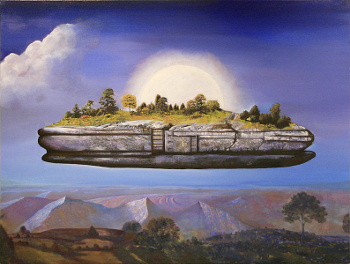
Utopien 04, a painting by Efthymios (Makis) Warlamis (1942-2016).
Utopias are often depicted as levitated. The Star Trek episode, The Cloud Minders, has a floating Utopian city.
(Wikimedia Commons image.)
My first experience with levitation was very early in my
career when I was part of a team doing
experiments with an
alloy of
hafnium with
vanadium, HfV
2, a
superconductor at 9.57
K that also absorbs
hydrogen.[1] Hafnium, which is most commonly used as an additive to
nickel alloys to promote protection from
oxidation, has a very high
melting point, 2,233
°C.
Vanadium likewise has a high melting point, 1500 °C, and hafnium is a very
reactive metal. This leads to the problem of how to melt vanadium, alloy it with hafnium in a process that evolves quite a bit of heat, while not destroying the crucible or contaminating the alloy.
The solution was to
levitate and heat the metals in a
vacuum using a
high power induction coil, as shown in the figure.
Radio frequency currents in an
induction coil induce
eddy currents in metals contained within, and these currents heat the metals.
Induction heating is a
common industrial technique used to
case harden items such as
automobile crankshafts. The coils are formed from
copper tubing so that they can be
water cooled to not melt from
radiant heat.
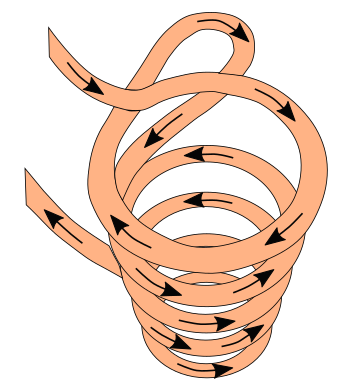
A levitation coil, commonly made from water-cooled copper tubing.
The arrows show the direction of an instantaneous current.
A nice example of levitation heating can be seen in this YouTube video.
(Created using Inkscape.)
The currents induced by the coil in the metals levitate them while also heating. The top coil turn is wound in an opposite direction to prevent the specimen from flying out of the coil. The
conical shape concentrates the currents at the bottom to stabilize levitation, and the shape can hold the metal pieces before levitation. After solving the problem of
tuning our particular coil to the
frequency of the
RF generator with some
high voltage capacitors, we were able to levitate specimens of several tens of
grams.
This method uses
magnetism as the levitating
force, since the induced currents produce a
magnetic field in the specimen that opposes the magnetic field of the currents in the coil. Another magnetic effect,
direct diamagnetic levitation, relies on the
diamagnetism of many materials, including
water, that opposes a magnetic field.
Nobel Laureate,
Andre Giem, and
physicist,
Michael Berry, famously levitated a
frog in a 20
tesla magnetic field.[2]
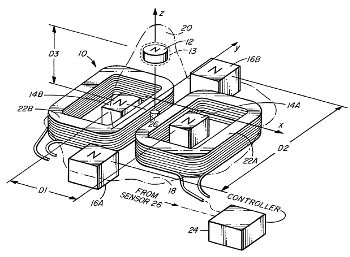
It's all done with mirrors magnets.
(Fig. 1 of US Patent No. 7,348,691, "Magnetic levitation apparatus," by Harold Davis and Lorne Whitehead, March 25, 2008, via Google Patents[3].)
Winds generate considerable force, so it's not surprising that objects can be
levitated by airflow.
Vertical wind tunnels have been created as "indoor skydiving" simulators that levitate humans. A cute
television commercial, found on
YouTube, illustrates such a simulator. It's easy to levitate a
light ball in an upwards airstream, and the ball remains in a stable position, since the
Bernoulli effect will drag the ball back to center if it wanders away. Since
sound is a pressure
wave, sound can be used to levitate, also, as a 2016 demonstration of levitating a 50 mm
diameter hollow
polystyrene ball by 25
kHz ultrasonic transducers has shown.[4]
Most
children have been taught the principle that "warm air rises, and cold air sinks," a short-form statement of
convection. Convection allows movement of air without using a
fan, all you need is a
hot plate, so levitation is possible in that manner. Obviously, you need a lot of
air for such levitation; or, do you? As a
research team led by a pair of
undergraduate students from the
Department of Physics,
The University of Chicago (Chicago, Illinois), has shown, it's possible to levitate
lightweight objects in between a warm and cold plate in a partial vacuum.[5-6] The students are 3rd year Frankie Fung and 4th year Mykhaylo Usatyuk.[6]
This levitation is termed
thermophoresis, and it's a
phenomenon first observed in
gas mixtures in 1870 by
John Tyndall (1820-1893). It depends on the different response to a
temperature gradient of different components in a mixture, and the mixture can be an
aerosol of fine particles in a gas. In a 2009 study,
dust aggregates of
micrometer-sized particles were levitated over a hot plate as aggregates from 100 μm to 1
cm in size.[7] It was found that levitation occurred at
pressures from 1-40
millibar when the temperature exceeded 400 K.[7] The advance made by the Chicago team is to transcend the simple case of levitation of small particles and their aggregates to stable levitation of larger objects for periods up to an hour.[6]
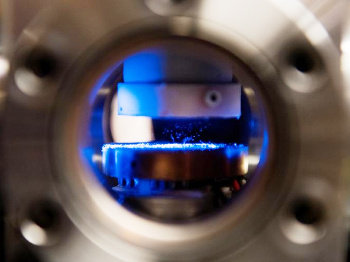
Thermophoretic levitation vacuum chamber.
Levitation is between an upper cold plate and a lower warm plate.
(University of Chicago image by Jean Lachat.)
In the Chicago experiments, the air pressure was 1-10
torr, and the size of the levitated particles were between 10 μm and 1
mm.[5] The bottom plate, made of
copper, was kept at
room temperature (about 300 K) while a
stainless steel cylinder filled with
liquid nitrogen served as the top plate with a constant temperature of 77 K.[6] The particles could be suspended indefinitely with a proper plate
geometry that included an ideal
ratio of the plate sizes, spacing, and
parallel alignment.[6] A misalignment of just a
degree severely reduced the levitation stability.[6] Says
Cheng Chin,
professor and leader of the
ultracold atomic and molecular physics group at the University of Chicago,
"Only within a narrow range of pressure, temperature gradient and plate geometric factors can we reach stable and long levitation... Different particles also require fine adjustment of the parameters."[6]
The levitated particles were stable both
radially and
vertically, radial stability achieved by the increasing temperature field, and vertical stability achieved by the transition to
hydrodynamic behavior as the particles ascend.[5] The research team levitated
polyethylene spheres under various conditions to examine the limits of the levitation process.[5] While magnetic levitation will only work if the particles are magnetic, and
optical levitation requires that objects can be
polarized by
light, the thermophoretic levitation will work on any material.[6]
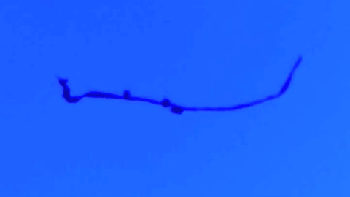
Thermophoretic levitation of lint.
(University of Chicago/Chin Lab video.)
This levitation mechanism will be especially useful in a
microgravity environment, where larger particles can be manipulated.[6] The research team speculates that the process could facilitate
assembly of small
micro-electro-mechanical (MEMS) devices.[6] Chin's laboratory is pursuing levitation of objects larger than a
centimeter in size.[6]
Funding for this research was provided by the
National Science Foundation, the
Grainger Foundation and the
Enrico Fermi Institute.[6]
References:
- P. Duffer, D.M. Gualtieri, and V.U.S. Rao, "Pronounced Isotope Effect in the Superconductivity of HfV2 Containing Hydrogen (Deuterium)," Phys. Rev. Lett., vol. 37, no. 21 (November 22, 1976), pp. 1410-1413.
- Andrey Geim, "Everyone's Magnetism," Physics Today, vol. 51, no. 9 (September, 1998), pp. 36-39, doi: http://dx.doi.org/10.1063/1.882437. A PDF file can be found here.
- Harold Davis and Lorne Whitehead, "Magnetic levitation apparatus," US Patent No. 7,348,691, March 25, 2008 (Google Patents).
- Marco A. B. Andrade, Anne L. Bernassau, and Julio C. Adamowski, "Acoustic levitation of a large solid sphere," Appl. Phys. Lett., vol. 109, no, 4 (July 25, 2016), Article No. 044101,doi: http://dx.doi.org/10.1063/1.4959862 .
- Frankie Fung, Mykhaylo Usatyuk, B. J. DeSalvo, and Cheng Chin, "Stable thermophoretic trapping of generic particles at low pressures," Applied Physics Letters, vol. 110, no. 3 (January 16, 2017), Article No. 034102, doi: http://dx.doi.org/10.1063/1.4974489.
- Greg Borzo, "New method uses heat flow to levitate variety of objects," University of Chicago Press Release, February 14, 2017.
- Thorben Kelling and Gerhard Wurm, "Self-Sustained Levitation of Dust Aggregate Ensembles by Temperature-Gradient-Induced Overpressures," Phys. Rev. Lett., vol. 103, no. 21 (November 20, 2009), Article No. 215502, https://doi.org/10.1103/PhysRevLett.103.215502.
Permanent Link to this article
Linked Keywords: Joke; invention; inventor; universal solvent; bottle; scientist; material; contamination; contaminate; sample; heat; metal; temperature; crucible; levitation; levitate; Efthymios (Makis) Warlamis (1942-2016); Utopia; Star Trek; episode; The Cloud Minders; Wikimedia Commons; career; experiment; alloy; hafnium; vanadium; superconductivity; superconductor; kelvin; K; hydrogen; nickel; oxide; oxidation; melting point; celsius; °C; chemical reaction; reactive; electrodynamic suspension; vacuum chamber; high power; inductance; induction coil; radio frequency; electric current; eddy current; induction heating; induction hardening; case harden; car; automobile; crankshaft; copper tubing; water cooling; water cooled; thermal radiation; radiant heat; YouTube video; Inkscape; cone; conical; resonance; tune; frequency; signal generator; RF generator; high voltage; capacitor; gram; magnetism; force; magnetic field; direct diamagnetic levitation; diamagnetism; water; Nobel Prize in Physics; Nobel Laureate; Andre Giem; physicist; Michael Berry; frog; tesla; mirror; magnet; Google Patents; wind; aerodynamic levitation; airflow; vertical wind tunnel; television commercial; table tennis ball; Bernoulli effect; sound; wave; diameter; polystyrene; hertz; kHz; ultrasonic transducer; child; children; convection; mechanical fan; hot plate; air; research; undergraduate education; undergraduate student; Department of Physics; The University of Chicago (Chicago, Illinois); lightweight; thermophoresis; phenomenon; gas; mixture; John Tyndall (1820-1893); temperature gradient; aerosol; dust; micrometer; centimeter; cm; pressure; millibar; thermophoretic; vacuum chamber; Jean Lachat; torr; millimeter; mm; copper; room temperature; stainless steel; cylinder; liquid nitrogen; geometry; ratio; parallel alignment; degree; Cheng Chin; professor; ultracold atomic and molecular physics group; parameter; radius; radial; vertical; fluid dynamics; hydrodynamic; polyethylene; sphere; optics; optical; polarization; polarized; light; lint; micro-g environment"; microgravity environment; nanotechnology; assembly; >micro-electro-mechanical (MEMS) device; funding; National Science Foundation; Grainger Foundation; Enrico Fermi Institute.